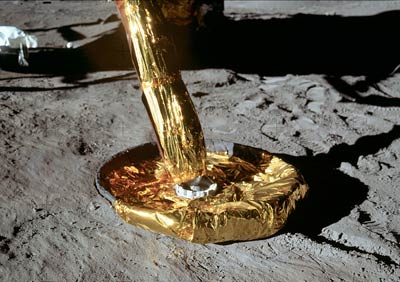|
|
 Nearly 40 years ago people around the world were transfixed by Apollo 11; will a new generation be similarly entranced by a return to the Moon? (credit: NASA) |
A moment in time
by Anthony Young
Monday, September 8, 2008
On July 20, 1969 I sat with a group of people in the lobby of the Seaview Hotel in Ocean City, New Jersey, our eyes focused on a small television set. The Lunar Module Eagle had landed on the Moon with Neil Armstrong and Buzz Aldrin, and we were waiting for Armstrong to emerge from the LM and make his way down to the lunar surface. All of us were aware we were witnessing an unprecedented historic event, one that we would tell our children and grandchildren. Soon, the live video image appeared on the screen, upside down at first, then corrected by Mission Control.
Armstrong emerged, feet first, then carefully moved to the ladder and slowly descended, rung by rung. None of us in the tightly packed group moved. The astronaut paused on the last rung, and then dropped onto the LM’s landing pad, something Armstrong had practiced countless times. We were transfixed as we watched the ghostly image on the TV screen.
“I’m at the foot of the ladder,” Armstrong reported. “The LM footpads are only depressed in the surface about one or two inches, although the surface appears to be very, very fine grained, as you get close to it. It’s almost like a powder. Now and then it’s very fine. I’m going to step off the LM now… That’s one small step for a man… one giant leap for mankind.”
It was a moment in time that will forever remain fixed in my mind and for everyone in that room who watched as one of the greatest moments in history unfolded before our eyes. If there was one word to describe that moment it was wonder. The dream of man for centuries was happening in our lifetime, and we were witness to it. We watched as Armstrong walked carefully across the lunar surface, adjusting to one-sixth gravity. Aldrin came down the ladder and then there were two American astronauts on the Moon.
| If there was one word to describe that moment it was wonder. The dream of man for centuries was happening in our lifetime, and we were witness to it. |
Armstrong and Aldrin went about their tasks with well-practiced ease. They collected samples, deployed experiments, took photographs and planted the American flag. Their stay at Tranquility Base lasted less than a day, and their only EVA was just over two and a half hours. They re-entered the lunar module with their precious lunar samples and made preparations to leave the Moon. When Eagle’s ascent engine fired and performed as designed, there were collective sighs all across the United States. Armstrong and Aldrin rendezvoused with Michael Collins in the Command and Service Module and the three astronauts headed home to Earth.
When their capsule splashed down in the Pacific Ocean, America experienced a wave of euphoria not seen since the end of World War 2. The three Apollo 11 astronauts toured the United States and the world, receiving a justified heroes’ welcome everywhere they went. It was one of the finest moments in American history—an all too brief moment in time when the United States proved to the world this country had the financial might and collective will to accomplish the most ambitious and technologically difficult goal of the 20th century. Project Apollo was the prelude to manned exploration of our solar system. Project Constellation must continue that goal worthy of a great nation.
Anthony Young is the author of The Saturn V F-1 Engine: Powering Apollo into History (September 2008) and Lunar and Planetary Rovers: The Wheels of Apollo and the Quest for Mars (2006) both published by Springer-Praxis.
|
|
